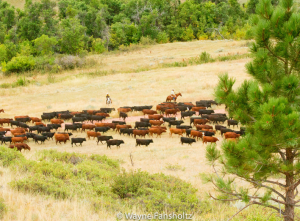Concerns When Feeding Sprouted Grain to Cattle
 By Megan Van Emon, MSU Extension Beef Specialist
By Megan Van Emon, MSU Extension Beef Specialist
Summer in Montana has been a wild ride. Because of the weather, grain harvest was delayed in many areas, and some barley and wheat have sprouted in the seed heads. These sprouted grains, although not suitable for traditional markets, can be used as a feedstuff for livestock.
Based on the research, sprouted grains have similar feed value to non-sprouted grains. Daily gains and feed efficiency in the feedlot are similar between cattle consuming non-sprouted or sprouted grains. However, due to the high starch content of wheat and barley, feeding below 20% of the total ration on a dry matter basis is recommended to minimize incidences of acidosis. For the greatest benefit of feeding wheat and barley, either sprouted or not, the kernels should be rolled or cracked, and should never be self-fed or used for creep feeding. Fine grinding of wheat and barley should be avoided.
 Major areas of concern when feeding sprouted grains are proper storage and the potential development of mold and mycotoxins. Proper storage of the sprouted grains is crucial to maintaining quality and limiting mold growth. If moisture levels are less than 13 percent, it can be stored as you would ordinarily store grain. When determining moisture levels of a field, make sure multiple samples are collected. Moisture content may vary across the field depending on topography and wind, which would cause uneven drying the sprouted grain. If moisture levels are greater than 13%, ensiling may be a better option for storage. Sprouted grains can be ensiled in silos, bunkers, or storage bags. Whole grain does not pack well, so rolling or cracking of the grain should be done prior to ensiling. Sprouted grains, such as barley and wheat, can be layered with corn silage during silage packing to ensile the sprouted grain.
Major areas of concern when feeding sprouted grains are proper storage and the potential development of mold and mycotoxins. Proper storage of the sprouted grains is crucial to maintaining quality and limiting mold growth. If moisture levels are less than 13 percent, it can be stored as you would ordinarily store grain. When determining moisture levels of a field, make sure multiple samples are collected. Moisture content may vary across the field depending on topography and wind, which would cause uneven drying the sprouted grain. If moisture levels are greater than 13%, ensiling may be a better option for storage. Sprouted grains can be ensiled in silos, bunkers, or storage bags. Whole grain does not pack well, so rolling or cracking of the grain should be done prior to ensiling. Sprouted grains, such as barley and wheat, can be layered with corn silage during silage packing to ensile the sprouted grain.
Due to high moisture of the sprouted grains and with cool weather conditions, mold may develop. If mold is seen on sprouted grains, it is recommended to collect multiple samples from the field. Proper drying of sprouted grains may occur on the outer edges and will be less susceptible to mold and mycotoxin production compared to the center of the field. Mold and mycotoxin levels should be assessed prior to feeding or harvesting because they can be hazardous to both humans and livestock. Barry Jacobsen, MSU Extension Plant Pathology, cautions that the dose of the mold or mycotoxin is very important when feeding potentially moldy feed. Jacobsen suggests that when submitting samples to labs, mold species and genus should be identified if possible. If mycotoxins are present in the sprouted grains at moderate levels, the sprouted grains should be combined with clean, non-moldy feed to reduce mycotoxin levels. For more, please contact your local Extension Office.



















